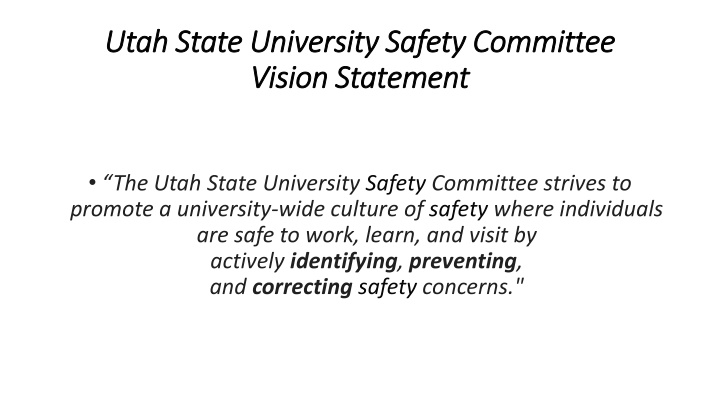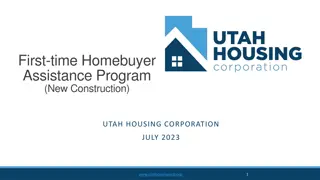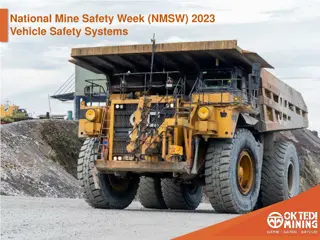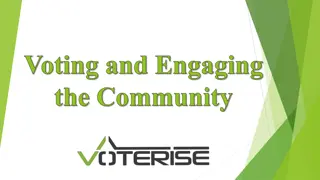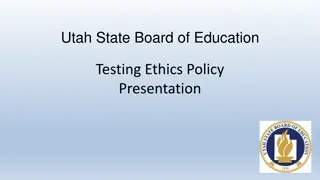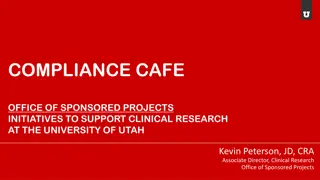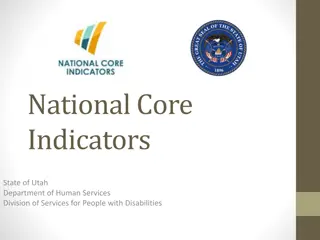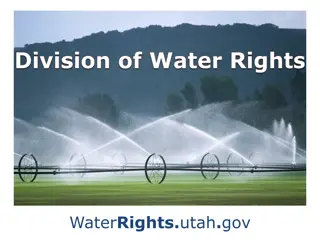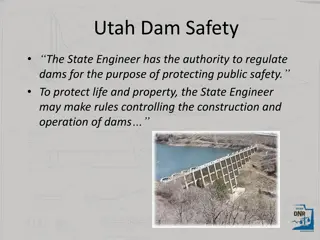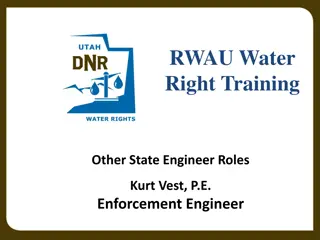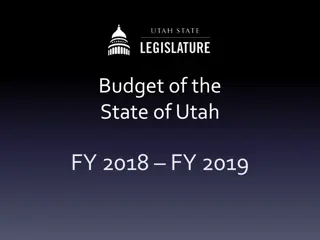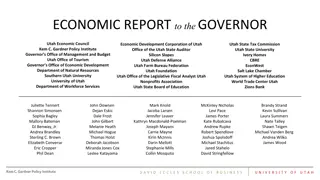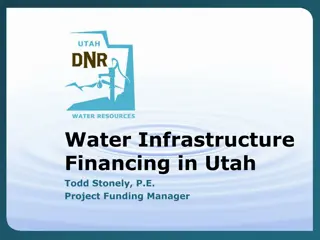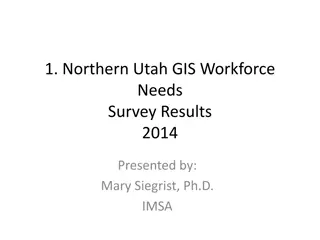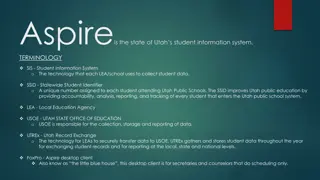Safety Initiatives at Utah State University
The safety committees at Utah State University are dedicated to fostering a culture of safety across the campus by identifying, preventing, and correcting safety concerns. They focus on areas such as promoting safety plans, ensuring chemical hygiene, and enhancing field safety and emergency response protocols. Improvement measures include tracking safety plans, monitoring accident rates, and providing adequate training.
Download Presentation

Please find below an Image/Link to download the presentation.
The content on the website is provided AS IS for your information and personal use only. It may not be sold, licensed, or shared on other websites without obtaining consent from the author.If you encounter any issues during the download, it is possible that the publisher has removed the file from their server.
You are allowed to download the files provided on this website for personal or commercial use, subject to the condition that they are used lawfully. All files are the property of their respective owners.
The content on the website is provided AS IS for your information and personal use only. It may not be sold, licensed, or shared on other websites without obtaining consent from the author.
E N D
Presentation Transcript
Utah State University Safety Committee Utah State University Safety Committee Vision Statement Vision Statement The Utah State University Safety Committee strives to promote a university-wide culture of safety where individuals are safe to work, learn, and visit by actively identifying, preventing, and correcting safety concerns."
USU Environmental Health & Safety Identify Identify, Prevent Prevent, & Correct Correct Three Priorities Why & How? Why are these impactful? Good safety plans promote a strong culture of safety The use and maintenance of engineered safety controls reduces hazards Slips, Trips, and Falls remains the #1 Accident at USU How will improvement be measured? Track and quantify approved Safety Plans Increased functionality of equipment Monitor accident rates New/preventative measures? Safety Plan evaluation is part of the annual review Develop a USU Safety Plan library Help USU Administrators, Faculty, Staff and Students develop, implement, evaluate and apply Safety Plans as outlined on Policy 337.3 Facilitate the implementation, inspection, and maintenance of Engineered Safety Infrastructure across USU camps Help promote Safe Travel Walking, Driving, Traveling 1. 2. 3.
Chemical Hygiene Committee Identify Identify, Prevent Prevent, & Correct Three Priorities 1. Chemical Hygiene Plans All laboratories are required to complete and update a CHP annually 2. Laboratory Close-outs Chemicals, equipment, etc. should be dealt with prior to faculty leaving the University 3. Training Training requirements should match activities personnel are involved in Track using ILS (?) Correct Why & How? Why are these impactful? 1. Creation and maintenance of a CHP provides vital lab specific hazard information. 2. Chemicals are not being left for others to deal with. 3. Personnel would receive training appropriate to the task. How will improvement be measured? 1. Annual accounting of who does and does not have an updated CHP. 2. Start tracking laboratory close-outs and when they do not occur. 3. Focused safety training and documentation New/preventative measures? 1 and 3 are established practices but communication and documentation needs improvement 2. Policy needed at the university level with implementation
Field Safety/EHS Identify Identify, Prevent Prevent, & Correct Correct Why & How? Three Priorities 1. Emergency Response Plans 2. Communications plans 3. Ensure all employees are trained on how to submit an accident report. 1. Why are these impactful? 1. Without clear emergency response plans and communications plans/pathways, planning and emergency response can be delayed. 2. Not knowing how to effectively investigate an accident and report it can lead to similar accidents in the future. (Heinrich Pyramid) How will improvement be measured? 1. Successful completion and review of Field Safety Plans 2. Adequate supervisor investigations in accident reports to ServiceNow New/preventative measures? 1. Field Safety Plan, peer review of research, communications, and safety plans, and the continuance of fostering a culture of safety here at USU 2. 3.
Institutional Biosafety Committee (IBC) Identify Identify, Prevent Prevent, & Correct Correct Three Priorities 1. Review all approved protocols annually. 2. Ensure labs with approval protocols meet the requirements of the BMBL 6th Edition. 3. Ensure laboratory SOPs are updated and reviewed by all personnel at least annually. Why & How? 1. Why are these impactful? 1. Help ensure funding is not jeopardized 2. Enhance safety in all BSL-2&3 labs 2. How will improvement be measured? 1. With an annual review report 3. New/preventative measures? 1. These will be on a case-by-case bases and then communicated and applied with other labs as applicable
Radiation Safety Committee Identify Identify, Prevent Prevent, & Correct Correct Three Priorities 1. Ensure compliance with DWMRC 2. Ensure all X-ray and radioactive material users are trained; establish laser training 3. Routinely audit the system Why & How? 1. Why are these impactful? Maintains our license; supports the research enterprise; reduces health risks 2. How will improvement be measured? Tally of training; quantify accidents and violations at in-lab visits 3. New/preventative measures? Departmental information sheet on equipment that requires authorization and/or training
Caine College Safety Priorities: AWARE Identify Identify, Prevent Prevent, & Correct AWARE Correct Three Priorities Be AWARE 1. I: Identify Checklist-(a safety issue): training, safety, equipment, availability of safety items P: Prevention: Annual training, review safety sheets SOP s before operation. C: Correction: Run & review training + work with the Safety Office to improve communication. Make sure safety equipment and literature is available. 1. A Actively participate in safety training. 2. W Watch & Witness to ensure equipment is safely used. 3. A Adjust and improve to create a keen awareness. 4. R Respect each other and respect equipment. 5. E Engage early to improve communication about 2. 3. SOP s.
CAAS Three Priorities 1. Recommit to PPE Why & How? 1. Why are these impactful? a. Increase PPE compliance b. Expand vision beyond laboratories 2. How will improvement be measured? a. Dept self-evaluations b. Increase proportion of plans on hand 3. New/preventative measures? a. As needed in classroom/teaching labs 2. Risk/safety assessments in classroom/teaching laboratory settings 3. Census of safety plans in farm/field work settings
College of Engineering/Biological Engineering Identify Identify, Prevent Prevent, & Correct Correct Three Priorities 1. Develop a shared digital chemical inventory. 2. Develop standardized lab door placards indicating lab layout, hazards, emergency resources. 3. Develop online resources for lab use requirements. Why & How? 1. Why are these impactful? Will facilitate tracking, storage, sharing, disposal of all chemicals 2. How will improvement be measured? Real-time updates on a web server or box folder 3. New/preventative measures? Link key card lab access to required user trainings as posted on each lab door
College of Humanities and Social Science Identify Identify, Prevent Prevent, & Correct Correct Three Priorities Why & How? 1. This is impactful because the Staff Committee isn t aware of an evacuation plan 2. Improvements will be measured by training per department 3. This information will be distributed with the help of the college s staff committee 1. Create an evacuation plan for emergencies 2. Ensure all employees are trained on the evacuation plan 3. Ensure employees & students have clear access to the evacuation plan
College of Science Identify, Prevent, & Correct Three Priorities 1. Maintain safety infrastructure to deal with fainting incidents during tours of Cadaver lab 2. Improve safety instruction for field trips 3. Campus-wide: separation of electric wheeled and pedestrian traffic on paved pathways Why & How? 1. Why are these impactful? CoS has fainting incidents during tours of Cadaver lab every year 2. How will improvement be measured? Possible reduction of incidents 3. New/preventative measures? Open to suggestions
College of Education and Human Services Identify Identify, Prevent Prevent, & Correct Correct Three Priorities 1. Review safety incidents from past three years and identify common safety concerns in the college. 2. Ensure all employees are trained on how to submit an accident report. 3. Review Emergency Response Plans for College Why & How? 1. Why are these impactful? 1&3 will provide insights into safety issues and preparedness. 2 will train faculty in accurate and timely reporting 2. How will improvement be measured? Safety representatives will discuss, identify gaps, and report at semesterly safety committee meetings 3. New/preventative measures? Identification of common safety concerns (1) and challenges will allow the development of new prevention measures and better trained employees (2 & 3) will promote a safer environment.
Extension Safety Priorities: Identify Identify, Prevent Prevent, & Correct Correct Three Priorities Why & How? 1. Provide participants, including youth, with safe educational experiences Train volunteers on safety related policies and procedures Off- and On-campus Extension faculty using county-owned, public, or private facilities should be knowledgeable of local emergency/safety plans Why are these impactful? Extension faculty provide experiential learning opportunities throughout the state in a variety of settings, many of which are not controlled by USU. How will improvement be measured? Volunteer background checks and trainings; participant enrollment; staff and volunteers trained in safety- related policies and procedures. New/preventative measures? Improvements and best practices will be discussed in the SC Safety Meeting, staff meetings, and county director meetings. Trainings will be provided as needed. 2. 3.
USU Jon M Huntsman School of Business Identify Identify, Prevent Prevent, & Correct Correct Three Priorities Why & How? 1. Increases survival rates curing cardiac emergencies (staff training required). 2. Enhances response time for emergency services. 3. Reduces risk of slips, trips, and falls in winter months. 1. Proper AED Training to employees. 2. Find a better way to give actual addresses of locations on campuses, and train staff. 3. Educate employees and give them the number to contact Facilities in the winter months to report icy or slick spots.
QCNR Safety Priorities: Identify Identify, Prevent Prevent, & Correct Correct Three Priorities Why & How? 1. Maintain Safety Plans 2. Maintain Communication of Common Risks, Injuries, and Remedies to Members of our College. 3. Increase Support for Spot Trackers, Satellite Phones These can be updated for annual review and posted on department websites to keep everyone up to date.
USU Fire Marshals Office Identify Identify, Prevent Prevent, & Correct Correct Three Priorities Why & How? 1. Items #1 and #2 are already requirements and have impact not only for the safety of my employees, but also shows that we respect the safety environment established by the construction companies and the lab personnel. 2. Zero injuries. 3. Crampons would be a new measure to keep employees from injuries due to slipping on ice. This would result in less injuries reported to Workman s Comp, reduced time off of work, and potentially improve quality of life for employees. 1. Meet OSHA requirements on construction site visits by wearing hard hats, safety glasses, hard toe boots, and safety vests. Wear proper PPE when the need arises to enter BLS-3 labs and research areas. Obtain and wear crampons while walking around on campus during extremely icy conditions. 2. 3.
Department of Public Safety Identify Identify, Prevent Prevent, & Correct Correct Three Priorities 1. Ensure all employees are aware properly trained on all safety requirements as they pertain to their respective assignments. 2. Ensure all employees are trained on how to submit an accident report. 3. Ensure employees receive proper training of equipment before use. Why & How? 1. Why are these impactful? It provides a clear understanding of all safety requirements that employees are expected to follow. Understanding and knowing the reporting routes go hand in hand. 2. How will improvement be measured? Tracking of all requirements and training of employees. Number of incidents vs number of reports officially submitted. 3. New/preventative measures? Department safety officer/champion. Creation of training and tracking sheets.
Dining Services Identify Identify, Prevent Prevent, & Correct Correct Three Priorities 1. Update Knife Safety Training and make sure all employees complete annually. 2. Replace flooring in dish room. 3. Update Safety training to include proper lifting and team lift guidelines and have employees complete annually. Why & How? 1. Why are these impactful? Our most common causes of accidents are cuts, slips, muscle strains, and burns. These address 3 of the 4. 2. How will improvement be measured? Safety trainings will be tracked in ILS. Floor will be replaced in May. 3. New/ Preventative Measures? Safety concerns will be reviewed in manager meetings to ensure we are addressing most pressing issues.
USU Facilities USU Facilities Safety Priorities Three Priorities Why & How Emergency Response Plan Overall impact will be an increased preparedness in responding to emergency situations Measurement: fully developed plan and implementation. New Hire Safety Onboarding Data analysis has shown new hires with less than 1 year on the job suffer injuries at a greater rate than their peers. Measurement: Reduction in new hire injuries. Meet with Area Supervisors that have high frequency of injuries Supervisors have meaningful impact on expectation of safety among their crew. Measurement: Meet with all identified area supervisors which leads to reduction of injuries within those areas.
Dept. of Libraries Identify Identify, Prevent Prevent, & Correct Correct Three Priorities 1. Update Emergency Response Plans 2. Provide Employees emergency trainings on varying topics 3. Conduct Slip/Fall hazard assessment Why & How? Impact: Ensure safe operations and environment for patrons and employees Measures: Safety Committee will review the Emergency Response Plan and update with campus in the current FY, facilitate an employee training on Active Shooter response, and conduct a slip/fall assessment of the building working with appropriate divisional employees. 3. New issues and appropriate remedies will be implemented generated from the feedback and problems identified by the Safety Committee.
Statewide Campuses Safety Priorities: Identify Identify, Prevent Prevent, & Correct Correct Three Priorities Why & How? Why are these impactful? 1 &2. Creating ERPs and training employees will save lives in the most critical situations. 3. Identifying areas to improve will help us to prioritized and act. How will improvement be measured? SC Safety Reps will identify current status, track progress, and report in SC Safety Meeting. New/preventative measures? Improvements and best practices will be discussed in the SC Safety Meeting to increase implementation of effective measures. 1. Emergency Response Plans 2. Train employees for emergencies Identify relevant trainings 3. Conduct a Security Site Assessment Use Crime Prevention Through Environmental Design (CPTED) principles to identify gaps and determine actions
Division of Student Affairs Identify Identify, Prevent Prevent, & Correct Correct Three Priorities 1. Record trainings and certifications within division Current training and certified trainers 2. Reporting Standardize reporting channels 3. Education Who has obligation to report? Eliminate stigma around reporting Why & How? 1. Report on what trainings are currently required and offered within Division 2. Document standard procedures for division reporting 3. Educate current staff/students along with onboarding new hires
